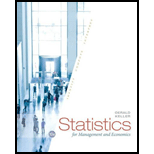Solutions for Statistics for Management and Economics
Browse All Chapters of This Textbook
Book Details
STATISTICS FOR MANAGEMENT AND ECONOMICS, Tenth Edition, emphasizes applications over calculation. It illustrates how vital statistical methods and tools are for today's managers--and teaches you how to apply them to real business problems. Using a proven three-step "ICI" approach to problem solving, the text teaches you how to IDENTIFY the correct statistical technique by focusing on the problem objective and data type; how to COMPUTE the statistics doing them by hand, using Excel, or using MINITAB; and how to INTERPRET results in the context of the problem. This unique approach enhances your comprehension and practical skills. The text's vast assortment of data-driven examples, exercises, and cases covers the various functional areas of business, demonstrating the statistical applications that marketing managers, financial analysts, accountants, economists, and others use. These comprehensive applications give you hands-on practice, while solid pedagogical elements make the material more accessible and easy to apply to your world. Completely up-to-date, the tenth edition offers comprehensive coverage, current examples, and Excel 2013 and MINITAB 16 content.
Sample Solutions for this Textbook
We offer sample solutions for Statistics for Management and Economics homework problems. See examples below:
More Editions of This Book
Corresponding editions of this textbook are also available below:
